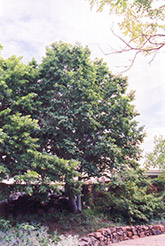Height: 50 feet
Spread: 25 feet
Sunlight:
![]()
![]()
Hardiness Zone: 2
Other Names: White Alder
Description:
An effective and tidy shade tree for moist or naturalized locations such as along a riverbank or lakeshore; no individually outstanding attributes, but no major negative characteristics either; best in wet locations
Ornamental Features
Gray Alder is primarily valued in the landscape for its distinctively pyramidal habit of growth. It has dark green deciduous foliage. The serrated oval leaves turn yellow in fall.
Landscape Attributes
Gray Alder is a dense deciduous tree with a distinctive and refined pyramidal form. Its average texture blends into the landscape, but can be balanced by one or two finer or coarser trees or shrubs for an effective composition.
This is a relatively low maintenance tree, and is best pruned in late winter once the threat of extreme cold has passed. It has no significant negative characteristics.
Gray Alder is recommended for the following landscape applications;
- Shade
Planting & Growing
Gray Alder will grow to be about 50 feet tall at maturity, with a spread of 25 feet. It has a high canopy with a typical clearance of 6 feet from the ground, and should not be planted underneath power lines. As it matures, the lower branches of this tree can be strategically removed to create a high enough canopy to support unobstructed human traffic underneath. It grows at a medium rate, and under ideal conditions can be expected to live for 80 years or more.
This tree does best in full sun to partial shade. It is quite adaptable, prefering to grow in average to wet conditions, and will even tolerate some standing water. It is not particular as to soil type or pH. It is highly tolerant of urban pollution and will even thrive in inner city environments. This species is not originally from North America.
